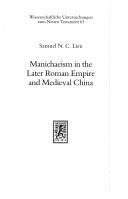| Listing 1 - 4 of 4 |
Sort by
|

ISSN: 03409570 ISBN: 3161458206 9783161458200 Year: 1992 Volume: 63 Publisher: Tübingen: Mohr,
Abstract | Keywords | Export | Availability | Bookmark
 Loading...
Loading...Choose an application
- Reference Manager
- EndNote
- RefWorks (Direct export to RefWorks)
Manichaeism --- Manichéisme --- History --- Histoire --- China --- Rome --- Chine --- Religion --- 273.21 --- -Manichaeism --- -Dualism (Religion) --- Philosophy, Ancient --- Manicheïsme --- Christianity --- Religion. --- 273.21 Manicheïsme --- -Manicheïsme --- -273.21 Manicheïsme --- Manichéisme --- Manichaeism. --- Manicheïsme. --- Manichäismus. --- Geschichte. --- Mani. --- China. --- Rome (Empire). --- Römisches Reich. --- Religion romaine. --- Dualism (Religion) --- Manichaeism - Rome --- Manichaeism - China --- Manichéens --- Rome - Religion --- China - Religion
Book
ISBN: 9782503512471 250351247X Year: 2010 Volume: 6 Publisher: Turnhout: Brepols,
Abstract | Keywords | Export | Availability | Bookmark
 Loading...
Loading...Choose an application
- Reference Manager
- EndNote
- RefWorks (Direct export to RefWorks)
This volume of the Corpus Fontium Manichaeorum brings together a large number of excerpts in Greek and Latin from both Manichaean and anti-Manichaean sources on the sect's central teaching on cosmogony and ethics. The texts have been translated by a seasoned team of classical scholars who have endeavoured to produce a translation which is both accurate and fluent. The volume contains excerpts from key Manichaean texts found in Egypt and other parts of the Roman Empire as well as from the writings of Church Fathers like Serapion of Thmuis, Titus of Bostra, Epiphanius, Cyril of Jerusalem and, above all, Augustine of Hippo. Excerpted also are relevant sections of pagan anti-Manichaean sources such as Alexander of Lycopolis and Simplicius. The texts and translation are accompanied by a commentary and by detailed word indices. This volume will prove essential to all scholars of Manichaeism and of the Study of Religions.
273.21 --- Manicheïsme --- Manichaeism --- Manichaeism. --- Quelle --- Manichäismus --- Kosmogonie --- Ethik --- History --- History. --- Griechisch. --- Latein --- 273.21 Manicheïsme --- Quelle. --- Manichäismus. --- Kosmogonie. --- Ethik. --- Latein.
Book
ISBN: 2503511562 9782503511566 Year: 2001 Volume: 4 Publisher: Turnhout: Brepols,
Abstract | Keywords | Export | Availability | Bookmark
 Loading...
Loading...Choose an application
- Reference Manager
- EndNote
- RefWorks (Direct export to RefWorks)
Manichaeism --- Dualism (Religion) --- Philosophy, Ancient --- Christianity --- Manichaeism - Early works to 1800.
Book
ISBN: 9782503521978 2503521975 Year: 2012 Volume: 2 Publisher: Turnhout Brepols ; Sydney : Ancient cultures research centre, Macquarie University
Abstract | Keywords | Export | Availability | Bookmark
 Loading...
Loading...Choose an application
- Reference Manager
- EndNote
- RefWorks (Direct export to RefWorks)
Better known to Western medieval travelers as Zayton, Quanzhou in Fujian was China's main port and also the terminus of the maritime Silk Road. The city was home to a cosmopolitan population especially when China was under Mongol rule (ca. 1280-1368 CE). Italian visitors to and inhabitants of the city included Marco Polo, Odoric of Pordenone and Andrew of Perugia. The city had a significant Christian population, both Catholic and Church of the East (Nestorian), and the nearby town of Jinjiang has to this day in its neighbourhood a Manichaean shrine housing a unique statue of Mani as the Buddha of Light. These religious communities left a wealth of art on stone which first came to light in the mid-twentieth century but is still very little known and studied outside China. This volume containing over 200 illustrations (many in full colour) is the work of a team of scholars from Australian universities in collaboration with the major museums in Quanzhou and Jinjiang and is the first major work on this unique material in a Western language.
Christian antiquities --- Manichaeism --- Excavations (Archaeology) --- Christian art and symbolism --- Antiquities. --- Christian antiquities. --- Christian art and symbolism. --- Excavations (Archaeology). --- Manichaeism. --- Missions. --- Inschrift. --- Funde. --- Manichäismus. --- Christliche Archäologie. --- Franciscans --- Franciscans. --- Missions --- China --- Quanzhou Shi (China) --- China. --- Quanzhou. --- Church history. --- 27 <51> --- 273.21 --- S13A/0700 --- Kerkgeschiedenis--China --- Manicheïsme --- China: Religion--Manicheism --- 273.21 Manicheïsme
| Listing 1 - 4 of 4 |
Sort by
|

 Search
Search Feedback
Feedback About UniCat
About UniCat  Help
Help News
News